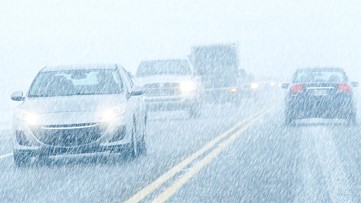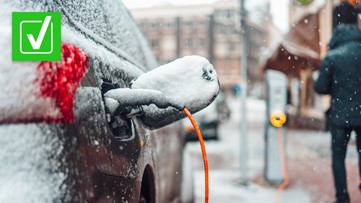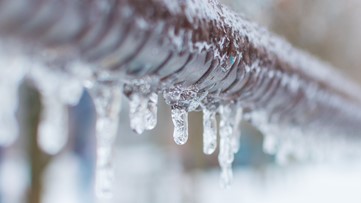Hurricane season officially began on June 1 and will last until Nov. 30.
Every year, the National Oceanic and Atmospheric Administration publishes predictions for the season. This year, NOAA predicts an “above-average” season, with 17 to 25 named storms. Four to seven of those storms are predicted to be major hurricanes.
NOAA attributes “near-record warm ocean temperatures in the Atlantic Ocean, development of La Nina conditions in the Pacific, reduced Atlantic trade winds and less wind shear” as potential factors in the higher-than-average season.
VERIFY answered top questions about hurricanes, including what the five categories mean and whether insurance policies cover flood damage from the storms.
THE SOURCES
- The National Oceanic and Atmospheric Administration (NOAA)
- The National Hurricane Center
- Florida Climate Center at Florida State University
- The Insurance Information Institute (III)
- Federal Emergency Management Agency (FEMA)
- U.S. Centers for Disease Control and Prevention (CDC)
- American Red Cross
- Insurance companies Allstate and Amica
- Florida Division of Emergency Management
WHAT WE FOUND
QUESTION #1: How long does hurricane season last?
THE ANSWER
The Atlantic hurricane season runs from June 1 to Nov. 30 every year. The Atlantic basin includes the Atlantic Ocean, Caribbean Sea and the Gulf of Mexico, according to the National Hurricane Center (NHC).
More than 97% of Atlantic tropical storm and hurricane activity occurs during this six-month period, according to the National Oceanic and Atmospheric Administration (NOAA). However, hurricanes can and do occur outside of the designated season.
Most Atlantic hurricane activity occurs between mid-August and late October due to warm ocean waters that support the storms’ development, the Florida Climate Center explains.
QUESTION #2: What’s the difference between tropical storms, typhoons and hurricanes?
THE ANSWER
Tropical storms, typhoons and hurricanes all fall under the designation of tropical cyclones.
All tropical cyclones use warm, moist air as fuel. That’s why the storms only form in tropical regions where the ocean temperature is at least 80 degrees, NOAA explains.
The storms also need wind to form. As the wind passes over the ocean’s surface, water evaporates and rises. The water vapor cools as it rises and condenses back into large water droplets, forming clouds.
Though tropical storms, typhoons and hurricanes are all considered tropical cyclones, there are differences between the three types of storms.
The first difference is wind speed. Tropical cyclones become tropical storms if their sustained winds reach 39 mph or higher. If wind speeds reach 74 mph or higher, the storm is then classified as a hurricane.
Hurricanes and typhoons are the same type of weather phenomena – the only difference between the two is their location, according to NOAA.
Hurricane is used for storms that originate in the North Atlantic, central North Pacific and eastern North Pacific, while the word typhoon is used for storms that form in the Northwest Pacific, NOAA says.
Storms that form in the South Pacific and Indian Oceans are always referred to as tropical cyclones, regardless of their wind speeds.


QUESTION #3: What do the five hurricane categories mean?
THE ANSWER
The five-category Saffir-Simpson Hurricane Wind Scale estimates the severity of the storm and its impacts. “Major hurricanes” fall under Categories 3, 4 and 5 on the scale.
The scale is a 1 to 5 rating based on a hurricane’s peak wind speeds. It does not take into account other hazards such as storm surge, flooding and tornadoes, the NHC says.
Once a storm reaches 74 mph winds or greater, it is assigned a hurricane category.
Here is the NHC’s breakdown of the five hurricane categories and what they mean:
- Category 1: Winds of 74 to 95 mph. "Very dangerous winds will produce some damage." Some homes could have damage to their roofs, vinyl siding and gutters. Extensive damage to power lines and poles will likely result in power outages that could last a few to several days.
- Category 2: Winds of 96 to 110 mph. “Extremely dangerous winds will cause extensive damage.” Some homes could sustain major roof and siding damage. Near-total power loss is expected with outages that could last from several days to weeks.
- Category 3: Winds of 111 to 129 mph. “Devastating damage will occur.” Some homes may incur major damage. Electricity and water will likely be unavailable for several days to weeks after the storm passes.
- Category 4: Winds of 130 to 156 mph. “Catastrophic damage will occur.” Homes can sustain severe damage, with loss of most of the roof and/r some exterior walls. Power outages could last weeks to months. Most of the area will likely be uninhabitable for weeks or months.
- Category 5: Winds of 157 mph or higher. “Catastrophic damage will occur.” A high percentage of homes will be destroyed, with total roof failure and wall collapse. Power outages will last for weeks to possibly months. Most of the area will be uninhabitable for weeks to months.
Category 6 hurricanes do not exist, despite some viral claims.
QUESTION #4: Do homeowners and renters insurance policies cover flood damage from hurricanes?
THE ANSWER
Homeowners and renters insurance policies do not typically cover flood damage from hurricanes.
Instead, people can purchase separate flood insurance policies from private companies or the National Flood Insurance Program (NFIP) managed by the Federal Emergency Management Agency (FEMA). These policies can cover buildings, such as your home, the contents within, or both.
Flood insurance through the NFIP is available to anyone living in one of the 23,000 participating communities throughout the United States.
To find a flood insurance provider through the NFIP, you can use the federal government’s online tool or call 877-336-2627.
There can be a 30-day waiting period before a flood insurance policy goes into effect, with some exceptions, so it’s best not to wait to buy coverage until severe weather is expected to hit your area.
QUESTION #5: How can you prepare for a hurricane or tropical storm?
THE ANSWER
Before a hurricane hits your area, the CDC recommends preparing an emergency supply kit.
That kit should include the following items:
- Emergency food and water supply.
- An emergency medicine supply.
- Emergency power sources such as flashlights and extra batteries.
- Copies of important documents such as wills, passports and personal identification.
- A fire extinguisher.
The Red Cross offers tips to prepare your home for an impending storm. They include bringing in outdoor items such as lawn furniture and trash cans, anchoring objects that would be unsafe to bring inside such as gas grills and propane tanks, trimming or removing trees close enough to fall on your home, and protecting windows with permanent storm shutters or sheeting.
To protect your home from flooding, the Red Cross recommends cleaning out drains, gutters and downspouts, stockpiling materials such as plastic sheeting and sandbags, and installing a sump pump with a battery backup.
If you have a generator, do not use it indoors due to the risk of carbon monoxide poisoning. You shouldn’t use a generator in the rain, either, unless you have a canopy or another suitable cover.
The Florida Division of Emergency Management also has tips for making a family plan before a disaster strikes.
The Associated Press contributed to this report.
This story is also available in Spanish / Lee este artículo también en español: Huracanes: Hoja de Datos VERIFY













